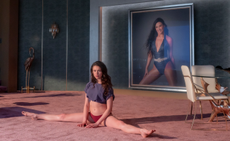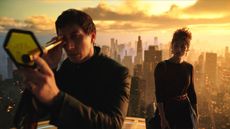Enter the immersive world of film noir at a disused hospital in Venice
Fondazione In Between Art Film returns to Venice with ‘Nebula’, by curators Alessandro Rabottini and Leonardo Bigazzi

Two years ago, ‘Penumbra’ was a surprise hit at the Venice Biennale. Who would have thought a group show of film would be so popular at an event where people are known to ‘power walk’ through exhibitions that have been months or even years in the making?
For the Venice Biennale 2024, the Fondazione In Between Art Film – which commissions art films and stages exhibitions – returns with ‘Nebula’, a different staging in the same space, a disused hospital, by the same curators, Alessandro Rabottini and Leonardo Bigazzi. The building, Complesso dell’Ospedaletto, constructed over 400 years, is an enigmatic maze of rooms looking onto a courtyard that is both impossible to ignore and adaptable to staging. Working with the same designers, 2050+, the team took a more immersive approach than with ‘Penumbra’, letting the films guide the installation while keeping the sense of noir they adopted in 2022.

Basel Abbas and Ruanne Abou-Rahme, Until we became fire and fire us,2023–ongoing in “Nebula”, Fondazione InBetween Art Film at Complesso dell’Ospedaletto, Venice,2024.Courtesy of the artists, and Fondazione In Between Art Film
‘We wanted to use the same space, and clearly we were working with the same medium, so we started thinking of how to give a different experience to viewers,’ says Rabottini. ‘The dynamic was slightly different. We were aware of the space, and we made [the viewers] aware of the space.’
Each of the eight films has its own unique setting – variously defined, for example, by foil-lined walls, padded white medical fabric, or a ringing bell – which overflows out of its location into the rest of the building. There is a sense of dissonance and miasma as you negotiate the exhibition before landing on a work in its particular space.
‘Nebula’, by Fondazione In Between Art Film in Venice

Giorgio Andreotta Calò, Nebula, 2024 in “Nebula” Fondazione InBetween Art Film at Complesso dell’Ospedaletto, Venice,2024.Courtesy of the artists, and Fondazione In Between Art Film
On entering the venue’s 18th-century chapel, you are greeted by the towering triptych of Basir Mahmood’s Brown Bodies in an Open Landscape are Often Migrating (2024). A multi-channel work playing on three huge screens, designed to mimic the shape of a phone, dominates the space. A call and response is taking place; men beckon each other or signal with flags and we see shots of a rocky landscape mirroring the hand gestures of the frescoes that decorate the walls, barely visible in the near darkness. The film tells the story of those who migrate, walking through rural areas of Pakistan and how they communicate. Using social media and other methods, people share information on how to travel, their journeys sometimes taking years.
‘If you see from a Central European point, mostly people realise that these migrants exist when they are at their borders or at their shores,’ the artist says. ‘But these journeys take place, sometimes, over five or eight years, and they start travelling when as young as 12 years old. So imagine you start as a young boy, you end up as a teenager or a man when you arrive, and most of the time you don't end up there. For me, it was important to speak about the density, the vastness of the space and also the time that it takes to reach any destination.’
Chrisitan Nyampeta’s film When Rain Clouds Gather (2024), which follows three friends in New York trying to plan a night out, looks at the difficulties of different roles and positions in the art world. Through the lives of these friends, Nyampeta explores how politics, ideals and realities transfer from discussion into real life.
Wallpaper* Newsletter
Receive our daily digest of inspiration, escapism and design stories from around the world direct to your inbox.
‘For this film, I wanted to experiment with conventions alongside friends and collaborators, in search of forms that move at the rhythm of life,’ he reveals. ‘I wanted to find a way to commemorate and to imagine and to inspire into action, but never to manipulate.’
In the work, the friends discuss high and low culture, why one international crisis captures the public’s imagination and not another, and the dilemma of making art and maintaining a steady life and income.
‘If this film raises dichotomies, it is only because life itself is painfully contradictory’ continues Nyampeta. ‘The principal role of this film is to support ongoing and preceding conversations about what to do and how to do it in the face of the brutality from those who are supposed to look after us. The film does this playfully and with a lot of creativity and openness. Perhaps the resulting tension between the global histories bearing upon the world today paired with life's little annoyances create what can be described as dichotomies.’
Installed in the most recently built part of the hospital is Until we became fire and fire us (2023-ongoing) by Basel Abbas and Ruanne Abou-Rahme. Installed across five rooms, this work uses poetry, installation, music, performance and drawing, with several interlinked films to explore states of being related to their Palestinian heritage.
Another standout work is Ari Benjamin Meyers’ Marshall Allen, 99, Astronaut (2024) – a loving portrait of a 99-year-old flautist who is the last living member of the Sun Ra Arkestra jazz group – rounding out a stunning ensemble of works that make ‘Nebula’ a highlight of the biennale.
‘Nebula’, until 24 November 2024 at Complesso dell’Ospedaletto, Venice, inbetweenartfilm.com
For more must-sees, read our guide to the Venice Biennale 2024
Amah-Rose Abrams is a British writer, editor and broadcaster covering arts and culture based in London. In her decade plus career she has covered and broken arts stories all over the world and has interviewed artists including Marina Abramovic, Nan Goldin, Ai Weiwei, Lubaina Himid and Herzog & de Meuron. She has also worked in content strategy and production.
-
 Bali welcomes Tri Hita Karana Tower, a hybrid sound and vision centrepiece
Bali welcomes Tri Hita Karana Tower, a hybrid sound and vision centrepieceTri Hita Karana Tower is launching at Bali's Nuanu City; designed by Arthur Mamou-Mani, it’s a new hybrid art-AI architectural landmark for the island
By Ellie Stathaki Published
-
 Lego opens its first Superpower Studios at Paris’ La Gaîté Lyrique
Lego opens its first Superpower Studios at Paris’ La Gaîté LyriqueIn collaboration with Lego’s new Global Play Ambassadors, artists Aurélia Durand, Chen Fenwan and Ekow Nimako, and overseen by Colette co-founder Sarah Andelman, Paris is the site of the first Lego Superpower Studios
By Jonathan Bell Published
-
 ‘If kids grew up going to London Design Festival they would learn so much’: architect Shawn Adams
‘If kids grew up going to London Design Festival they would learn so much’: architect Shawn AdamsIn the first of our interviews with key figures lighting up the London Design Festival 2024, Shawn Adams, founder of POoR Collective, discusses the power of such events to encourage social change
By Ali Morris Published
-
 The Substance may be grotesque, but it is not body horror
The Substance may be grotesque, but it is not body horrorThe Substance, Coralie Fargeat's sophomore feature film, has already been granted the moniker body horror, due its visceral imagery and mutations of the body
By Billie Walker Published
-
 New film, Hollywoodgate, finds out what really happened when the US left Afghanistan
New film, Hollywoodgate, finds out what really happened when the US left AfghanistanFilmmaker Ibrahim Nash’at’s Hollywoodgate follows Taliban soldier MJ Mukhtar and air force commander Mawlawi Mansour in the aftermath of America’s withdrawal in August 2021
By Zoe Whitfield Published
-
 ‘Everything human-made is of interest to me’: Hildigunnur Birgisdóttir in Venice
‘Everything human-made is of interest to me’: Hildigunnur Birgisdóttir in VeniceArtist Hildigunnur Birgisdóttir explores consumerism at the Icelandic Pavilion at the Venice Biennale 2024
By Hannah Silver Published
-
 Toys, fantasy and the US immigration system: inside Julio Torres' debut film, Problemista
Toys, fantasy and the US immigration system: inside Julio Torres' debut film, ProblemistaJulio Torres writes, directs and stars in Problemista – now on digital release – where the nightmare of US immigration is given a surreal spin
By Hannah Silver Published
-
 First Fraenkel Film Festival in San Francisco: what to see
First Fraenkel Film Festival in San Francisco: what to seeThe Fraenkel Film Festival, at the Roxie Theater in San Francisco, sees ten Fraenkel gallery artists choose films that impact their work
By Lauren Cochrane Published
-
 Paul B. Preciado on his Orlando film: 'There is no trans question'
Paul B. Preciado on his Orlando film: 'There is no trans question'Paul B. Preciado interprets Virginia Woolf’s work in 'Orlando, My Political Biography'
By Sam Moore Published
-
 Cannes Film Festival 2024 highlights: our verdict is in
Cannes Film Festival 2024 highlights: our verdict is inWhat to watch or not to watch – cut to the Cannes Film Festival 2024 highlights
By Sophie Monks Kaufman Published
-
 Cyber-noia, pornography, and liberation: inside the queer sci-fi of Shu Lea Cheang
Cyber-noia, pornography, and liberation: inside the queer sci-fi of Shu Lea CheangShu Lea Cheang's new film, ‘UKI’, exists in two worlds simultaneously: the real world of flesh and blood, and a strange digital landscape
By Sam Moore Published